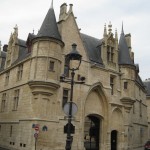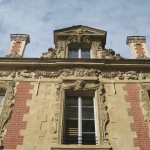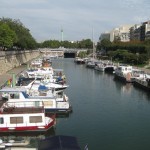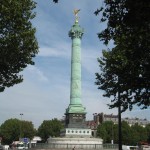buy provigil singapore The day started with a quick trip to the street market at Maubert, after a quick trip to check out another internet cafe nearby where we might be able to print our boarding passes.  Alas, the printer was en depanne – awaiting  repair!  The bright sunny day gave us the ambition to stroll another of our Paris walks.

Vegetables in Maubert's Street Market

The cheese man in Maubert's Street Market

Fish for sale in the Maubert Street Market
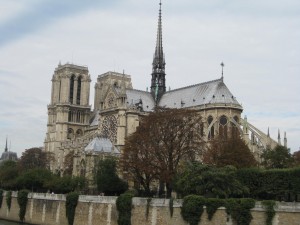
As we walked from the street market to the starting point of the walk, we passed Notre-Dame
This one is titled Storming the Galleries: Village St Paul and Bastille.
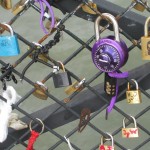
On the bridge across to Ile de Cite from the Left Bank, we found these locks latched to the bridge. Each lock has two first names or initials with a heart, signifying their everlasting devotion in the City of Love
The walk starts just off the rue de Rivoli near the St Paul Metro stop on rue de Figuier, at the Hotel de Sens, a perfect medieval residence from the 14th century.  It was remodeled in early 16th century to add a Gothic watchtower and give it the appearance of  a fortified castle.  On the eastern facade, there is a cannonball embedded in the stone – a stray from 1830.
From there we circled around a school playground that encloses a stretch of over 220 feet of the fortifications of Paris by Philip Augustus in 1190. Â Then we ducked into Village St Paul, an area of Paris we had never visited during our previous travels. Â It is a series of interconnected cobblestone courtyards with a series of restaurants, galleries, shops from high end to brocante, and workshops (attesting to its history as a modest working class area). Â The courtyards were bustling with students in small groups lunching on their take-away and, of course, smoking!
Past the pretty 1840 fountain in rue Charlemagne at the rear of the Church of St-Paul-St-Louis into a narrow little passage with a charming garden on the left. Â There is a plaque in the garden honoring a father and his three sons who perished in Auschwitz. Â Down another passage, also narrow and cobbled, into a side door of St Paul-St Louis, a church modeled on the Gesu in Rome. Â Its one remaining significant religious painting by Delacroix has been moved to the Louvre. Â The interior of the church features lofty ceilings, ornate carved woodwork, massive crystal and bronze chandeliers, and marble, marble, and more marble. Â The exterior of this church gives no clue as to its interior.
We slipped out the front door, onto rue St Antoine, a busy, busy shopping street with more reasonable prices. Â We passed by the Hotel de Sully, an elegant late Renaissance structure built by Jean Androuet de Cerceau. Â The walk had us turn down the calm rue du Petit Music, toward the Seine. Â At the end, at the quai, was the 16th century Hotel Fieubert, now a school and needing a little bit of a facelift. Â Just across the street, in square Henri Galli, a little park, there are chunks of the Bastille prison, found in rue St-Antoine when they excavated for the Metro.
The Pavillon d’Arsenal is surrounded by more modern, contemporary office buildings. Â We wound through the business people taking their cigarette breaks and headed over to Port de Plaisance de l’Arsenal, where colorful barges float along with pleasure craft of all sizes. Â We crossed the footbridge, walking along the side of the lock toward the Place de la Bastille. Â The lock is what remains of a canal built to support the tradespeople and manufacturers whose industrial processes required a waterway for raw materials and finished goods.
Place de la Bastille, was the site of a prison, stormed by revolutionaries on July 14 1789. The only physical reminder of the Bastille prison is the building outline on the pavement. Â Off to the east, the modern Opera Bastille, designed in the 1990’s, and home to most of the city’s operas today, is not my cup of tea. Â In fact, critics have likened its white tile exterior to an immense public lavatory. YUCK!
At the center of Place de la Bastille is the Colonne de Juillet, a column topped by a gilded Liberty, commemorating those who died in the three day revolution of 1830’s July. The remains of hundreds of victims of the two uprisings are in its crypt.
We abandoned the rest of the walking tour, heading over to the Marais’ A L’As du Fallafel, the place we thought we were visiting last week. Â We ordered the falafel plate and a rose (after all it is sunny and warm)! Â We thought it was better than the King of Falafel.
It was almost time for our appointment with Claire, to set up an account at Credit Agricole! Â Mon Dieu – the bureaucracy the French are known for! Â Over an hour later and copies of an entire portfolio of paperwork, we emerged with an account number. Â Our debit cards will be in the mail in about two weeks! Â Credit Agricole does not have credit cards – only debit cards – right now. Â So before our next trip, we’ll have to transfer some money into our account and then live on our French account! Else be subject to overdraft fees in excess of 17%.
For dinner, we met Emy and Carol at le Grand Colbert near the Bourse. Le Grand Colbert is a beautiful, old elegant restaurant that Emy had visited on her BD trip to Paris. Â Mike started with oysters, we selected grilled sea bass fillet, grilled swordfish, lamb chops, or veal liver. Â We ended our meal with housemade sorbets and ice creams. Â Then we headed off to the Metro for our ride back to our apartment to catch the flashing Eiffel Tower at 11 PM.


